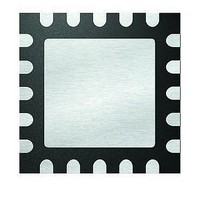PIC18LF13K22-E/ML Microchip Technology, PIC18LF13K22-E/ML Datasheet - Page 17

PIC18LF13K22-E/ML
Manufacturer Part Number
PIC18LF13K22-E/ML
Description
8KB Flash, 256bytes RAM, 256bytes EEPROM, 16MIPS, NanoWatt XLP 20 QFN 4x4mm TUBE
Manufacturer
Microchip Technology
Series
PIC® XLP™ 18Fr
Datasheets
1.PIC18LF13K22-ISS.pdf
(388 pages)
2.PIC18LF13K22-ISS.pdf
(12 pages)
3.PIC18LF13K22-ISS.pdf
(36 pages)
Specifications of PIC18LF13K22-E/ML
Core Processor
PIC
Core Size
8-Bit
Speed
48MHz
Connectivity
I²C, LIN, SPI, UART/USART
Peripherals
Brown-out Detect/Reset, POR, PWM, WDT
Number Of I /o
17
Program Memory Size
8KB (4K x 16)
Program Memory Type
FLASH
Eeprom Size
256 x 8
Ram Size
256 x 8
Voltage - Supply (vcc/vdd)
1.8 V ~ 3.6 V
Data Converters
A/D 12x10b
Oscillator Type
Internal
Operating Temperature
-40°C ~ 125°C
Package / Case
20-VQFN Exposed Pad, 20-HVQFN, 20-SQFN, 20-DHVQFN
Processor Series
PIC18LF
Core
PIC
Data Bus Width
8 bit
Data Ram Size
256 B
Interface Type
EUSART, I2C, SPI
Maximum Clock Frequency
32 KHz
Number Of Programmable I/os
18
Number Of Timers
4
Operating Supply Voltage
1.8 V to 3.6 V
Maximum Operating Temperature
+ 125 C
Mounting Style
SMD/SMT
3rd Party Development Tools
52715-96, 52716-328, 52717-734, 52712-325, EWPIC18
Development Tools By Supplier
PG164130, DV164035, DV244005, DV164005
Minimum Operating Temperature
- 40 C
On-chip Adc
10 bit, 12 Channel
A/d Bit Size
10 bit
A/d Channels Available
12
Height
0.88 mm
Length
4 mm
Supply Voltage (max)
3.6 V
Supply Voltage (min)
1.8 V, 2.7 V
Width
4 mm
Lead Free Status / RoHS Status
Lead free / RoHS Compliant
Lead Free Status / RoHS Status
Lead free / RoHS Compliant
- Current page: 17 of 388
- Download datasheet (4Mb)
2.4.1
The Primary External Oscillator can be enabled or dis-
abled via software. To enable software control of the
Primary External Oscillator, the PCLKEN bit of the
CONFIG1H Configuration register must be set. With
the PCLKEN bit set, the Primary External Oscillator is
controlled by the PRI_SD bit of the OSCCON2 register.
The Primary External Oscillator will be enabled when
the PRI_SD bit is set, and disabled when the PRI_SD
bit is clear.
2.4.2
The LP, XT and HS modes support the use of quartz
crystal resonators or ceramic resonators connected to
OSC1 and OSC2 (Figure 2-2). The mode selects a low,
medium or high gain setting of the internal inverter-
amplifier to support various resonator types and speed.
LP Oscillator mode selects the lowest gain setting of the
internal inverter-amplifier. LP mode current consumption
is the least of the three modes. This mode is best suited
to drive resonators with a low drive level specification, for
example, tuning fork type crystals.
XT Oscillator mode selects the intermediate gain
setting of the internal inverter-amplifier. XT mode
current consumption is the medium of the three modes.
This mode is best suited to drive resonators with a
medium drive level specification.
HS Oscillator mode selects the highest gain setting of the
internal inverter-amplifier. HS mode current consumption
is the highest of the three modes. This mode is best
suited for resonators that require a high drive setting.
Figure 2-2 and Figure 2-3 show typical circuits for
quartz crystal and ceramic resonators, respectively.
2010 Microchip Technology Inc.
Note:
PRIMARY EXTERNAL OSCILLATOR
SHUT-DOWN
The Primary External Oscillator cannot be
shut down when it is selected as the
System Clock. To shut down the oscillator,
the system clock source must be either the
Secondary Oscillator or the Internal
Oscillator.
LP, XT AND HS OSCILLATOR
MODES
Preliminary
PIC18F1XK22/LF1XK22
FIGURE 2-2:
Note 1: A series resistor (R
Note 1: Quartz crystal characteristics vary according
C1
C2
2: The value of R
2: Always verify oscillator performance over
3: For oscillator design assistance, reference
quartz crystals with low drive level.
selected (typically between 2 M to 10 M.
• AN826, “Crystal Oscillator Basics and
• AN849, “Basic PIC
• AN943, “Practical PIC
• AN949, “Making Your Oscillator Work”
to type, package and manufacturer. The
user should consult the manufacturer data
sheets for specifications and recommended
application.
the V
expected for the application.
the following Microchip Applications Notes:
Crystal Selection for rfPIC
Devices” (DS00826)
(DS00849)
Analysis and Design” (DS00943)
(DS00949)
Quartz
Crystal
R
S
DD
(1)
and temperature range that is
QUARTZ CRYSTAL
OPERATION (LP, XT OR
HS MODE)
F
varies with the Oscillator mode
OSC1/CLKIN
OSC2/CLKOUT
R
S
F
) may be required for
(2)
®
PIC
Oscillator Design”
®
Oscillator
DS41365D-page 17
®
MCU
®
and PIC
Sleep
To Internal
Logic
®
Related parts for PIC18LF13K22-E/ML
Image
Part Number
Description
Manufacturer
Datasheet
Request
R

Part Number:
Description:
Manufacturer:
Microchip Technology Inc.
Datasheet:

Part Number:
Description:
Manufacturer:
Microchip Technology Inc.
Datasheet:

Part Number:
Description:
Manufacturer:
Microchip Technology Inc.
Datasheet:

Part Number:
Description:
Manufacturer:
Microchip Technology Inc.
Datasheet:

Part Number:
Description:
Manufacturer:
Microchip Technology Inc.
Datasheet:

Part Number:
Description:
Manufacturer:
Microchip Technology Inc.
Datasheet:

Part Number:
Description:
Manufacturer:
Microchip Technology Inc.
Datasheet:

Part Number:
Description:
Manufacturer:
Microchip Technology Inc.
Datasheet:










